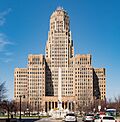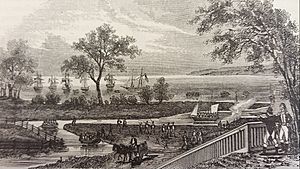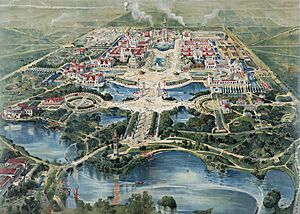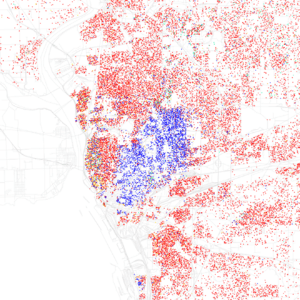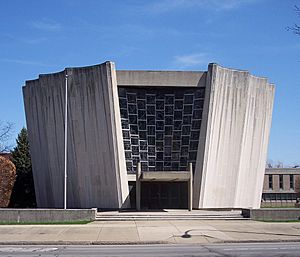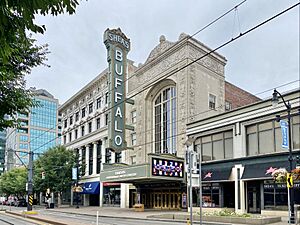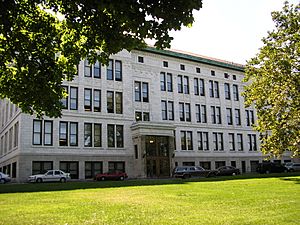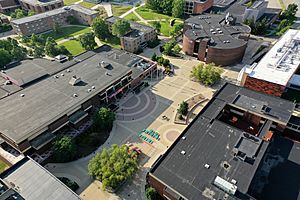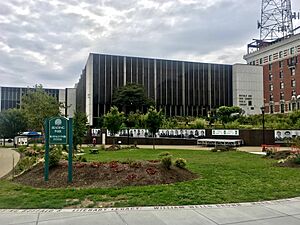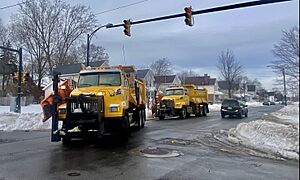Buffalo, New York facts for kids
Quick facts for kids
Buffalo
|
|||
|---|---|---|---|
|
Buffalo skyline
The Peace Bridge
NFTA Metro Rail
|
|||
|
|||
| Etymology: Named after the nearby Buffalo Creek, which was named by French and Moravian explorers | |||
| Nicknames:
Queen City, City of Good Neighbors, City of No Illusions, Nickel City, Queen City of the Lakes, City of Light, The Electric City, City of Trees
|
|||
| Country | |||
| State | |||
| Region | Western New York | ||
| Metro | Buffalo–Niagara Falls | ||
| County | Erie | ||
| First settled (village) | 1789 | ||
| Founded | 1801 | ||
| Incorporated (city) | 1832 | ||
| Named for | Buffalo River | ||
| Government | |||
| • Type | Strong mayor-council | ||
| • Body | Buffalo Common Council | ||
| Area | |||
| • City | 52.48 sq mi (135.92 km2) | ||
| • Land | 40.38 sq mi (104.58 km2) | ||
| • Water | 12.10 sq mi (31.34 km2) | ||
| Elevation | 600 ft (200 m) | ||
| Population
(2020)
|
|||
| • City | 278,349 | ||
| • Rank | US: 81st NY: 2nd | ||
| • Density | 6,893.41/sq mi (2,661.58/km2) | ||
| • Urban | 948,864 (US: 50th) | ||
| • Urban density | 2,786.7/sq mi (1,075.9/km2) | ||
| • Metro | 1,125,637 (US: 49th) | ||
| Demonyms | Buffalonian | ||
| GDP | |||
| • Buffalo–Niagara Falls (MSA) | $84.673 billion (2022) | ||
| Time zone | UTC−05:00 (EST) | ||
| • Summer (DST) | UTC−04:00 (EDT) | ||
| ZIP code |
142XX
|
||
| Area code(s) | 716, 624 | ||
| FIPS code | 36-11000 | ||
| GNIS feature ID | 0973345 | ||
Buffalo is a large city in New York State, located in Western New York. It sits at the eastern end of Lake Erie, where the Niagara River begins, right near the border with Canada. With over 278,000 people, Buffalo is the second-largest city in New York, after New York City. It's also the main city in the Buffalo–Niagara Falls metropolitan area, which has about 1.1 million residents.
Long ago, different Native American groups lived here. In the 1600s, French explorers arrived. Later, in 1825, Buffalo became the end point of the Erie Canal. This canal helped the city grow into a major port for trading grain between the Great Lakes and the Atlantic Ocean. When railroads became popular, Buffalo became a big railway center. Over time, the city's economy changed from mostly factories to service jobs like healthcare, tourism, and education.
Buffalo is known for its cool cultural spots, like the Buffalo AKG Art Museum and the Buffalo Philharmonic Orchestra. It also has many fun annual festivals. You might know Buffalo for its snowy winters and, of course, for inventing Buffalo wings! The city is also home to two major sports teams: the Buffalo Bills (football) and the Buffalo Sabres (hockey).
Contents
History of Buffalo
Buffalo has a rich history, from ancient times to today.
Early People and European Explorers

Thousands of years ago, nomadic people called Paleo-Indians lived in this area. Later, tribes like the Erie people, Neutral Nation, and Iroquois lived here. In the early 1600s, French explorers and missionaries were the first Europeans to visit.
The Seneca people, an Iroquois tribe, became powerful in the mid-1600s. They settled along Buffalo Creek around 1780. Famous explorers like Louis Hennepin and Sieur de La Salle explored the Niagara region in the late 1670s.
After the American Revolution, the land where Buffalo is now was sold to the Holland Land Company. In 1797, a man named Joseph Ellicott surveyed the land. He designed the village with streets like spokes on a wheel, meeting at what is now Niagara Square. The village was first called New Amsterdam, but soon its name changed to Buffalo.
The Erie Canal and Growth
The village of Buffalo got its name from Buffalo Creek. In 1813, during the War of 1812, British forces burned Buffalo. But the city was quickly rebuilt by 1815.
Buffalo was chosen as the end point for the Erie Canal, which opened in 1825. This canal brought lots of trade and business to the city. Buffalo became a city in 1832. Many immigrants from Ireland and Germany moved to Buffalo, helping it grow even faster.
Buffalo was also an important stop on the Underground Railroad in the 1840s. Many escaped slaves found freedom by crossing the Niagara River into Canada from Buffalo.
In 1843, Joseph Dart and Robert Dunbar invented the grain elevator in Buffalo. This machine made it much faster to unload grain from ships. Buffalo became the world's biggest grain port at that time. Later, railroads became very important, making Buffalo the second-largest railway hub in the U.S., after Chicago.
Steel and Modern Times
By the early 1900s, Buffalo was a leader in grain and flour milling. It was one of the first cities to use hydroelectricity from the Niagara River. In 1901, Buffalo hosted the Pan-American Exposition, a big fair that showed off new inventions and art. Sadly, President William McKinley was assassinated at this event.
Many factories, especially steel mills, grew in Buffalo. During World War II, Buffalo's factories made steel, chemicals, and aircraft for the war effort. In 1950, Buffalo was the 15th largest city in the U.S.
However, things changed. The opening of the St. Lawrence Seaway in 1959 meant ships could bypass Buffalo, which hurt its port. Many factories closed, and people lost jobs. This period is sometimes called "deindustrialization." Like many cities in the "Rust Belt", Buffalo has been working hard to rebuild its economy. Today, Buffalo focuses on new industries like healthcare and technology.
Geography and Climate
Buffalo is located in a unique spot, which affects its weather and landscape.
Where is Buffalo?
Buffalo is on the eastern shore of Lake Erie, right across from Fort Erie, Canada. The Niagara River starts here and flows north over Niagara Falls into Lake Ontario.
The city is mostly flat. Buffalo has four main waterways: the Niagara River, Buffalo River (and Creek), Scajaquada Creek, and the Black Rock Canal. The city also has many trees, with over 70,000 trees managed by the city's forestry department.
Buffalo covers about 52.5 square miles (136 square kilometers). About 40.38 square miles (104.58 square kilometers) is land, and the rest is water.
Buffalo's Buildings and Areas
Buffalo has many interesting buildings from the 1800s and 1900s. Downtown, you can see the Prudential (Guaranty) Building, an early skyscraper, and the Art Deco Buffalo City Hall. The Buffalo Central Terminal is another famous building, built in 1929.
Buffalo is divided into different areas, called neighborhoods. Main Street splits the city into the East and West sides. The West Side developed earlier and is generally more wealthy.
Many neighborhoods have been getting new investments and improvements since the 1990s. For example, the Larkin Terminal Warehouse was redeveloped into Larkinville, a lively area with businesses and homes. Downtown Buffalo has also seen a lot of growth, with more housing and new projects.
Buffalo's Weather
Buffalo has a humid continental climate, which means it has warm summers and cold, snowy winters. Lake-effect snow is common in winter. This happens when cold air moves over the warmer Lake Erie, picking up moisture and dropping it as heavy snow. Buffalo gets about 95 inches of snow each year on average.
Even with all the snow, Buffalo's operations are rarely stopped. However, very heavy snowstorms can cause problems, like the "Snowvember" storm in 2014, which brought over 5.5 feet of snow!
Buffalo's summers are usually sunny with moderate temperatures and humidity. Cool breezes from Lake Erie help keep the city from getting too hot. Temperatures usually go above 90°F (32°C) only a few times a year.
People and Culture
Buffalo is a diverse city with a mix of different cultures and traditions.
Who Lives in Buffalo?
| Historical population | ||
|---|---|---|
| Year | Pop. | ±% |
| 1810 | 1,508 | — |
| 1820 | 2,095 | +38.9% |
| 1830 | 8,668 | +313.7% |
| 1840 | 18,213 | +110.1% |
| 1850 | 42,261 | +132.0% |
| 1860 | 81,129 | +92.0% |
| 1870 | 117,714 | +45.1% |
| 1880 | 155,134 | +31.8% |
| 1890 | 255,664 | +64.8% |
| 1900 | 352,387 | +37.8% |
| 1910 | 423,715 | +20.2% |
| 1920 | 506,775 | +19.6% |
| 1930 | 573,076 | +13.1% |
| 1940 | 575,901 | +0.5% |
| 1950 | 580,132 | +0.7% |
| 1960 | 532,759 | −8.2% |
| 1970 | 462,768 | −13.1% |
| 1980 | 357,870 | −22.7% |
| 1990 | 328,123 | −8.3% |
| 2000 | 292,648 | −10.8% |
| 2010 | 261,310 | −10.7% |
| 2020 | 278,349 | +6.5% |
| Source: United States Census records and Population Estimates Program data. | ||
Before 1800, the Buffalo area was mainly home to Seneca and other Iroquois tribes. Later, people from New England and eastern New York moved in. In the 1830s to 1850s, many Irish and German immigrants came to Buffalo. At the start of the 1900s, Polish and Italian immigrants also settled here.
During the 1900s, many African Americans moved to Buffalo from the South for jobs. More recently, refugees from places like Myanmar, Somalia, and Iraq have made Buffalo their home. This has made Buffalo a "majority minority city," meaning that more than half of its residents belong to minority groups.
Buffalo's population grew a lot until 1950, when it was the 15th largest city in the U.S. After that, the population declined for many years as people moved to suburbs or other states. However, in the 2020 census, Buffalo's population grew by 6.5%, which was a positive change!
Religion in Buffalo
Christianity is the main religion in Buffalo. The Catholic Church has a large presence, with many churches and followers. A Jewish community also grew in Buffalo starting in the mid-1800s. The city's Temple Beth Zion is the biggest synagogue in the area.
With new immigrants and refugees, other religions like Islam and Buddhism have also grown in Buffalo. Some empty churches have even been turned into mosques and Buddhist temples. Hinduism also has a small but active community.
Buffalo's Economy
| Rank | Employer | Employees |
|---|---|---|
| 1 | Kaleida Health | 8,359 |
| 2 | Catholic Health | 7,623 |
| 3 | M&T Bank | 7,400 |
| 4 | Tops Friendly Markets | 5,374 |
| 5 | Seneca Gaming Corp. | 3,402 |
| 6 | Roswell Park Cancer Institute | 3,328 |
| 7 | GEICO | 3,250 |
| 8 | Wegmans | 3,102 |
| 9 | HSBC Bank USA | 3,000 |
| 10 | General Motors | 2,981 |
The Erie Canal was key to Buffalo's early economic success, making it a hub for shipping grain. Later, manufacturing, especially steel and car parts, became very important. When these industries slowed down, Buffalo's economy shifted to service jobs.
Today, the main industries are healthcare, business services (like banking and insurance), retail, tourism, and shipping. Some manufacturing still happens, focusing on advanced technology and research.
Big employers in Buffalo include healthcare networks like Kaleida Health and Catholic Health, and M&T Bank. Many well-known companies like Rich Products and New Era Cap Company are based here.
Buffalo's economy has been improving since the early 2010s, adding many new jobs. Even with challenges like the COVID-19 pandemic, the city is working to grow and create more opportunities.
Arts and Music in Buffalo
Buffalo has over 20 theater companies, with many located in the downtown Theatre District. Shea's Performing Arts Center is the biggest theater, showing Broadway musicals and concerts. Every summer, you can watch Shakespeare in Delaware Park outdoors for free.
The Buffalo Philharmonic Orchestra performs at Kleinhans Music Hall, which is known for its amazing sound. The orchestra has even been nominated for Grammy Awards.
KeyBank Center hosts many national music acts. Canalside also has outdoor summer concerts, which are very popular. Buffalo has a rich music history, with famous musicians like Rick James and the Goo Goo Dolls starting their careers here.
Buffalo's Food Scene
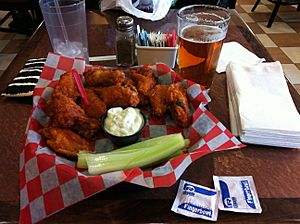
Buffalo is famous for its food! In 2015, National Geographic called Buffalo one of the "World's Top Ten Food Cities."
The most famous food is, of course, Buffalo wings! They were first made at the Anchor Bar in 1964. Buffalo wings are usually served with blue cheese dressing and celery. You can find them at many places, each with its own special recipe.
Buffalo also has many pizzerias, more per person than New York City! Other popular local foods include beef on weck (a roast beef sandwich), sponge candy, and fish fry (especially during Lent). The city also has many different ethnic restaurants, thanks to its diverse population.
Museums and Fun Things to Do
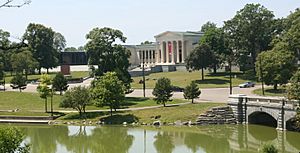
Buffalo is a great city to visit, with many cultural places. The Buffalo AKG Art Museum has a huge collection of modern and contemporary art. Nearby, the Burchfield Penney Art Center shows art by Charles E. Burchfield. You can also visit the Buffalo History Museum to learn about the city's past, or the Buffalo Museum of Science.
Canalside, Buffalo's historic waterfront, attracts over 1.5 million visitors each year. Here you'll find the Explore & More Children's Museum and the Buffalo and Erie County Naval & Military Park. You can also enjoy paddle-boating in the summer and ice skating in the winter.
Other fun attractions include the Theodore Roosevelt Inaugural National Historic Site, where President Roosevelt was sworn in, and the Buffalo Transportation Pierce-Arrow Museum.
Buffalo also hosts many festivals. The National Buffalo Wing Festival is held every Labor Day, serving millions of wings! The Taste of Buffalo is a big food festival in July. Other popular events include the Allentown Art Festival and Juneteenth celebrations.
Sports in Buffalo
| Team | Sport | League | Founded | Venue (capacity) | Championships |
|---|---|---|---|---|---|
| Buffalo Bills | American football | NFL | 1959 | Highmark Stadium (71,608) | 1964 and 1965 |
| Buffalo Bisons | Baseball | IL | 1979 | Sahlen Field (16,600) | 1997, 1998, 2004 |
| Buffalo eXtreme | Basketball | ABA | 2023 | XGen Elite Sports Complex | |
| Buffalo Sabres | Ice hockey | NHL | 1970 | KeyBank Center (19,070) | |
| Buffalo Bandits | Lacrosse | NLL | 1992 | KeyBank Center (19,070) | 1992, 1993, 1996, 2008, 2023, 2024 |
| FC Buffalo | Soccer | USL League Two | 2009 | All-High Stadium
(5,000) |
|
| FC Buffalo Women | Soccer | UWS | 2021 | All-High Stadium
(5,000) |
Buffalo is home to two major professional sports teams. The Buffalo Bills play football in the National Football League (NFL). They are the only NFL team based in New York State. The Bills won the American Football League Championship in 1964 and 1965. They also made it to four straight Super Bowls in the early 1990s.
The Buffalo Sabres play ice hockey in the National Hockey League (NHL). Both the Sabres and the Buffalo Bandits (a lacrosse team) play at KeyBank Center. The Bandits are the most successful team in the city, with six championships! All three teams are owned by Pegula Sports and Entertainment.
Many colleges and universities in Buffalo also have sports teams. The Buffalo Bulls and the Canisius Golden Griffins compete in NCAA Division I. Buffalo also has minor-league baseball with the Buffalo Bisons, who play at Sahlen Field.
Parks and Recreation
Buffalo is known for its beautiful parks. The city's park system was designed by Frederick Law Olmsted, who also designed Central Park in New York City. He wanted Buffalo to have a system of connected parks and trails. This system, finished in 1876, is considered the oldest in the U.S.
The largest park is Delaware Park, which covers 350 acres (140 hectares). It includes the Buffalo Zoo, Hoyt Lake, and a golf course. In the spring, you can see beautiful cherry blossoms in the park's Japanese Garden.
The city also has the Tifft Nature Preserve, a 264-acre (107-hectare) nature area with trails for hiking and cross-country skiing. Other parks include Cazenovia Park and South Park, which is home to the Buffalo and Erie County Botanical Gardens.
Buffalo has been working to turn its old industrial waterfront into fun recreational spaces. Canalside is a great example, with activities like paddle-boating in summer and ice skating in winter. Buffalo Harbor State Park also offers trails and open areas by the water.
Education in Buffalo
Buffalo has many schools and colleges for students of all ages.
Schools for Kids
The Buffalo Public Schools system has about 34,000 students in its elementary, middle, and high schools. There are about 60 public schools in total. The City Honors School is a top-ranked high school in the city.
Buffalo also has 20 charter schools and many private schools. These include Catholic schools like Canisius High School and Nardin Academy, as well as Islamic schools and non-religious options.
Colleges and Universities
The University at Buffalo (UB) is one of the biggest public universities in New York State. It has over 32,000 students and offers many different programs. UB is known for its research and is ranked among the top public universities in the U.S.
Buffalo State College is another large public college in the city. Buffalo also has several private colleges, including Canisius University, D'Youville University, and Villa Maria College. For two-year programs, there's SUNY Erie.
Libraries for Everyone
Buffalo's main library is the Central Library of the Buffalo & Erie County Public Library system. It has about two million books and even the original manuscript of Adventures of Huckleberry Finn by Mark Twain! The library system has eight branch libraries throughout the city, where you can get a free library card.
Transportation and Services
Buffalo has different ways to get around and important services for its residents.
Getting Around Buffalo

Buffalo is a port of entry with Canada. The Peace Bridge connects Buffalo to Canada across the Niagara River. Major highways like I-190, NY 5, and NY 33 help people travel in and out of the city.
The Niagara Frontier Transportation Authority (NFTA) runs Buffalo's public transportation. This includes buses and the Buffalo Metro Rail, a light-rail system that runs from Canalside to the University Heights area. The downtown part of the Metro Rail is free to ride!
The Buffalo Niagara International Airport in Cheektowaga has daily flights. Buffalo also has an Amtrak train station downtown, called Buffalo–Exchange Street station. For intercity buses, you can go to the NFTA's Buffalo Metropolitan Transportation Center.
Buffalo has been working to make its streets safer for bikes and pedestrians. Many new projects include bike lanes and improved walking paths.
City Services
Buffalo's water system is managed by Veolia Water. National Grid and New York State Electric & Gas provide electricity, and National Fuel Gas provides natural gas.
The city's Department of Public Works handles snow removal, trash collection, and street cleaning. During winter, snowplows clear the roads and sidewalks. Sometimes, driving bans are put in place during big snowstorms to keep everyone safe.
To prevent ice from blocking the Niagara River and affecting power plants, a special ice boom is installed each year. It stretches across the river from Buffalo to Canada.
Images for kids
Notable residents
Sister cities
Buffalo has eighteen sister cities around the world:
 Aboadze, Ghana
Aboadze, Ghana Baní, Dominican Republic
Baní, Dominican Republic Bursa, Turkey
Bursa, Turkey Cape Coast, Ghana (1976)
Cape Coast, Ghana (1976) Changzhou, China (2011)
Changzhou, China (2011) Dortmund, Germany (1972)
Dortmund, Germany (1972) Drohobych, Ukraine (2000)
Drohobych, Ukraine (2000) Horlivka, Ukraine (2007)
Horlivka, Ukraine (2007) Kanazawa, Japan (1962)
Kanazawa, Japan (1962) Kiryat Gat, Israel (1977)
Kiryat Gat, Israel (1977) Lille, France (1989)
Lille, France (1989) Rzeszów, Poland (1975)
Rzeszów, Poland (1975) Saint Ann, Jamaica (2007)
Saint Ann, Jamaica (2007) Siena, Italy (1961)
Siena, Italy (1961) Torremaggiore, Italy (2004)
Torremaggiore, Italy (2004) Wolverhampton, United Kingdom
Wolverhampton, United Kingdom Yıldırım, Turkey (2010)
Yıldırım, Turkey (2010)
See also
 In Spanish: Búfalo (Nueva York) para niños
In Spanish: Búfalo (Nueva York) para niños





